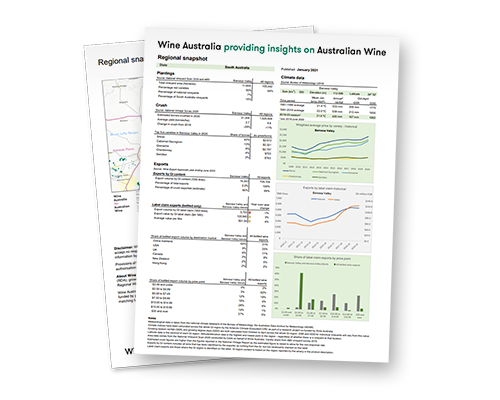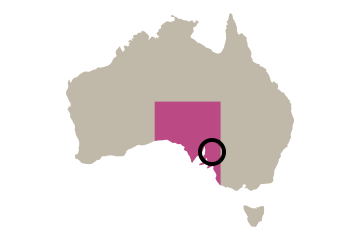Old vines and classic wines
The Barossa Valley region is located north-east of the city of Adelaide. The GI region is 578 km2 in size and has a total of 11,609 hectares of vineyards.
This region has warm grape-growing areas on the valley floor and cooler meso-climates at higher altitudes in the surrounding hills.
The main varieties grown in the region are Shiraz, Cabernet Sauvignon, and Grenache.

Barossa Valley Regional Snapshot 2024-25
Regional Snapshots are one-page profiles updated annually of individual Australian wine regions. They provide at-a-glance summary statistics on: climatic characteristics, viticulture data, winegrape production, and winegrape price and export sales data for wine, compared against the same statistics for the whole of Australia.
Download now



Cabernet Sauvignon
Tends to do best in the cooler sites and in cooler vintages in this region. The Barossa Cabernet style is generally richer with riper fruit character and softer tannins than Coonawarra and Margaret River.
Grenache
Often blended with both Shiraz and Mataro (GSM) to produce classic complex and textured red wines. Grenache is also made as a single varietal wine with rich with ripe raspberry and peppery spice character.
Riesling
The most important white variety of the region with classic lime flavours and aromas. Can age gracefully for 10 years or more.
Shiraz
Occupies 50% of the vineyard plantings and is the most famous variety in the Barossa. The Barossa has some of the oldest Shiraz vines in the world dating back to 1843. The style is typically full-bodied with ripe fruit and plush tannins; the very best examples moderate this natural richness with balanced acidity and a focused pure fruit character.

- The region has a Meditarranean climate ideal for full-bodied red wines, excellent fortified wines and generally robust white wines.
- The climate ranges from warm on the valley floor to cool at the higher altitudes in the hills surrounding the Valley.
- The region has a large diurnal temperature range, high maximum temperatures, high sunshine days and low humidity and rainfall.

- The complex system of valleys and twisting hills results in a variety of slopes, aspects and sites.
- The soils vary widely, but fall in a family of relatively low-fertility clay loam through to more sandy soils, ranging through grey to brown to red.
- As in so much of south-east Australia, acidity increases in the subsoils, restricting root growth and vigour.
